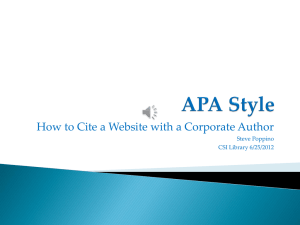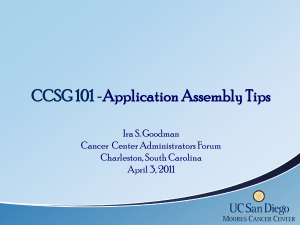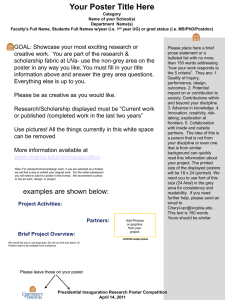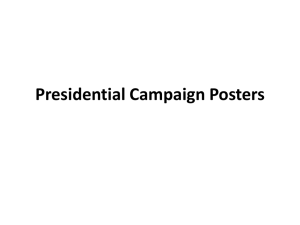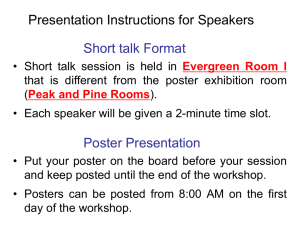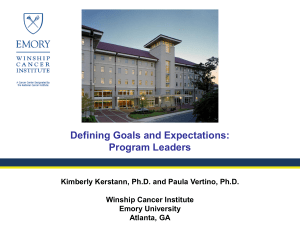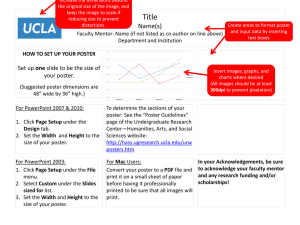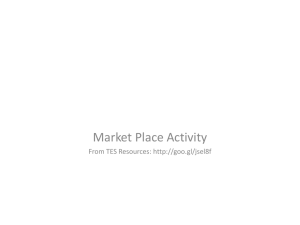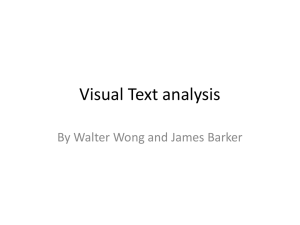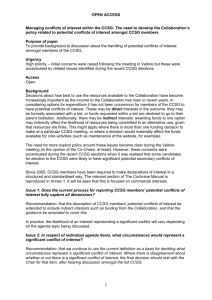Harrison - Moores Cancer Center
advertisement
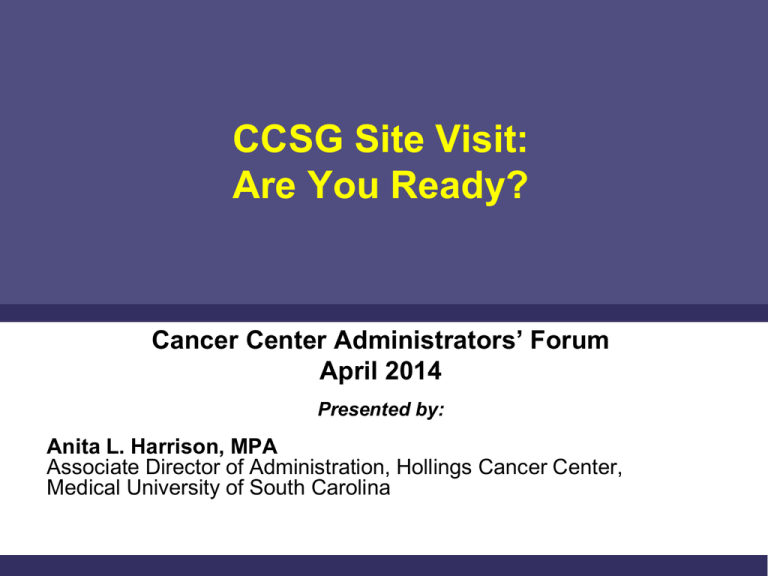
CCSG Site Visit: Are You Ready? Cancer Center Administrators’ Forum April 2014 Presented by: Anita L. Harrison, MPA Associate Director of Administration, Hollings Cancer Center, Medical University of South Carolina Site Visit Info NCI contacts you before the written CCSG submission to identify site visit dates and persons who would have conflicts of interest (COI) in reviewing your application - Site visit is 4-5 months after grant submission - You will be asked to provide several possible dates over a 2 month period; site visit will be on a Tues, Wed or Thurs (site visits are not held on Mon or Fri) - NCI might ask for hotel suggestions but NCI will arrange hotel and travel for site visitors - Conflicts of Interest (COI) – External Advisory Board (current and past); know who is on parent committee and review for COIs (former faculty, current collaborators, etc.) Parent Committee: NCI web site/Advisory Boards Advice 1: Don’t Wait Ideally: Don’t wait until the day after the CCSG grant submission to begin planning your site visit - Have a separate team working on site visit logistics 2 or more months before the grant submission - Identify suitable conference room for site visit - Notify and block travel for your Center and institutional leadership for the two months that your site visit may occur - Set dates for rehearsals and dress rehearsals; 1-2 should include EAB - Begin/finalize NIH biosketches for all membership - Web site should be updated/match grant - May need updated photography for PPT slides; if video is planned, begin making arrangements - Facility cleaning/repairs/upgrades Advice 1: Don’t Wait Ideally: Don’t wait until the day after the CCSG grant submission to begin planning your site visit - If you don’t have superb graphics talent on your staff, retain someone for 4-5 months leading up to site visit - Update pilot project investments – return on investment stats to be used in Developmental Funds (assuming you requested pilot project funding) - Begin collecting/reviewing meeting/retreat documentation - PRMS documentation (meeting and IIT documentation) - Set template for shared resource posters; set template for presentations - Identify and formalize contract with presentation coach (if used) - Develop a pending grant tracking mechanism in preparation of report Advice 2: Site Visit Room Set Up Size of site team depends on size of Center; average site team is in the 20-25 person range Room needs to be spacious enough to allow each reviewer plenty of “elbow” room (to open meeting book, have a lap top open and a place for plate/drink) Other designated seating areas needed for: - Senior Leadership - Other Center leaders/staff and institutional guests - Designated area for NCI staff (2-4 people) - Designated area for documentation (meeting minutes) Advice 2: Site Visit Room Set Up Seating - U shape is best layout for site visitors; prepare name tents for site visitors (and NCI staff); prepare name tags too - Provide the most comfortable chairs for site visitors and NCI staff - Assign all seats for guests—strategically place key leaders Most common complaint at site visits: TEMPERATURE Know who to call to adjust temperature quickly. Test it. - Make sure there are no scheduled fire drills, construction noises, etc. Remind everyone to turn off pagers, phones, etc. - Post staff outside door to enforce; ban use of devices during site visit Table for beverages/snacks in room, but lunch set up in separate room (Site visitors in executive session during lunch, need separate room for lunch for Center leadership) Advice 2: Site Visit Room Set Up IT/audiovisual - Have back up computer/projector plans - Every reviewer should have access to power strips for computers (have wires taped down in advance) - Every 2-3 reviewers need access to table top microphone - Have wireless access to internet for site visitors - IT/audiovisual people must be involved in all dress rehearsals Documentation - Have table in room if possible with all documentation (senior leadership meetings, program leader meetings, EAB meetings, strategic plan, evidence of any Center-sponsored research activities) - Have USBs available of grant as well as one hard copy - Provide mini prints of shared resource posters - Consider placemats identifying leadership, programs, SRs Advice 3: Site Visit Preparations Agenda is much more restricted under new guidelines - every minute is accounted for, no room for overages - agenda reviewed approved by NCI SRO - must have presentation time and Q&A time equal for every component Dress rehearsals (including catering, institutional leaders, tours) the number depends on the experience of the institution/leadership; 2 is a bare minimum; there should be at least 4-5 other modified/nondress rehearsals To script or not to script - Advantage: easier to control time; ensures that main points are made - Disadvantage: risk of putting reviewers to sleep - Have a time keeping/alert system Slides - use a common template but don’t force it - ban laser pointers; use effective animation Other Site Visit/Presentation Tips Consider the gender balance of your site visit presentations Do all of your Senior Leadership have a role in the site visit? Try to feature all of your Sr. Leaders Coach your presenters not be to defensive when questioned; have Director follow up in closing remarks Research your site visit team and share the information with your leadership; might help anticipate questions Arrange critical institutional leadership to stay for entire site visit (Dean, President, Provost) Hotel to Center transportation: have staff with phone on-site at hotel to escort site visitors; plan elevator strategy Other Site Visit/Presentation Tips Administration no longer expected to present but must have Q&A during site visit All scored elements should be clearly addressed in the presentations during the site visit - 6 essential characteristics (highlight changes/improvements) - Planning and Evaluation - Senior Leadership (not just who they are, but what they have done to move the Center forward) - Developmental Funds Program Presentations – 15-18 slides (well rehearsed) - Title Slide - Scientific Goals/Themes - Program Features - Center’s Value Added to Program - Program Expertise - 3 Scientific Examples (1-2 slides ea) - Future Plans - Q&A slide Advice 4: Administrative Review The Administrator is typically “pulled out” of the meeting just after the Director makes his/her first presentation for a discussion with the Administrative Reviewer for about an hour or less; have a 2nd in command in the site visit room who has been introduced to SRA Typical data requests at this meeting may include: - Request for updated information based on discussions from the reviewers the night before (status of pending grants, needing updated or missing biosketches, updated or missing budget information, clinical trial number discrepancies, etc.) - Clarifications on the Center’s budget—total Center budget for most recent FY and the sources of support for that budget for the most recent FY (pie charts are often helpful in conveying this info) Advice 4: Administrative Review A. Harrison typically looks for how the Administration supports the Center’s research efforts (similar to that of any shared resource) How does the staff administration participate in the Center’s decision making, planning and evaluation processes? Does the administration have adequate IT systems in place to provide efficient and effective services? How does administration foster the development of research and research collaborations? Advice 5 : Poster Session (optional) Poster data/info should match the write up or be clearly labeled as updated - Shared Resource (SR) Director should be able to clearly articulate the differences between the write up and the poster - Be sure to carefully label the graphs and what they represent Present exciting science that was produced with the shared resource (largest portion of the poster) SR Director: have usage logs at the poster - Administration should review these logs prior to the site visit to make sure data matches written grant Advice 5 : Poster Session If Shared Resource Director has communication or attitude challenges, place an Associate Director/Program Leader at that poster; each poster should have at least 2 representatives in case the site visitors want to tour resource If Co-SR Directors, be prepared to discuss the distinct responsibilities of each Rehearse the Shared Resource Directors too! - Oftentimes Shared Resources that are part of a larger University service are not as connected to the organization of the Cancer Center; make sure they are knowledgeable about the research programs and what exciting cancer research is ongoing - Be prepared to answer questions about subsidies and budget request Advice 6 : Tours Rehearse tours to every SR (path to getting to all sites of the resource; resource should have signage, prep staff, etc.) Clinical Trials (no longer a SR) but are toured during this time - Reviewers typically “quiz” the staff to make sure that the unit that was described on paper is “real” - Reviewers may ask for a demo of the capabilities of the IT system supporting the clinical trials unit - Typically, reviewers want to know the time it takes to open a study at the Center - If clinical coordination of trials is “decentralized”, are their shared SOPs, standards, communications, any dual reporting authority - Clinical trials unit should be restricted access, locked cabinets and clear observances of HIPAA Site Visit Expenses Poster printing and graphic design - Use a graphic designer to work with your Shared Resource Directors and leaders for their PowerPoint Site visit book for each reviewer (prefer spiral bound) - Agenda, color copies of slides, small poster prints, etc Food for breakfast, snacks and lunch (all participants) Transportation for site team to and from hotel and for tours to shared resources (if needed) Site Visit Expenses Additional audiovisual (may be extra costs) Additional honoraria/travel for EAB members if they attend dress rehearsals Presentation Coaches Hollings Cancer Ctr’s Site Visit Expenses CCSG Written Preparation Expenses Fed Ex Flash Drives Copies/Printing Temp Personnel (Grace Hummel) Reviewers/Editor $79.42 $400.00 $1,103.05 $11,752.02 $16,385.12 $29,719.61 CCSG Site Visit Preparation Expenses (excludes ESAB expenses for 2 rehearsals) Transportation General Supplies Food Posters/Book Printing Graphics/Photos/Video Temporary Personnel (Grace Hummel) Facilities (painting/cleaning) Coaches $300.00 $2,691.25 $3,532.96 $7,605.84 $11,855.00 $11,752.02 $12,190.25 $22,785.25 $72,712.57

